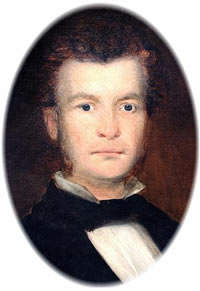
Photo
from original portrait
in Public Library of
Keokuk, Iowa
courtesy of Dave Thomson |
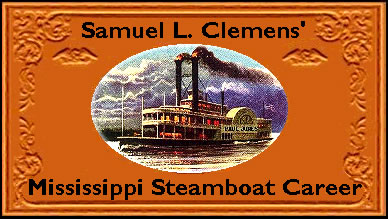
With graphics from the collection of
Dave Thomson
|
In February 1857 Samuel Clemens departed Cincinatti for New
Orleans aboard the steamboat PAUL JONES. Technically a passenger aboard the
boat, by the time he reached New Orleans he had convinced Pilot Horace Bixby
to take him on as an apprentice pilot. The following are a list of boats and
their descriptions that Clemens' worked about as a Cub Pilot.
Steamboat: PAUL JONES
Built: 1855
Tonnage: 353
Clemens' trip from Cincinnati to New Orleans: 16 February - 28 February
1857
Pilot: Horace Bixby
Co-Pilot: Jerry Mason
Captain: Hiram Hazlett
Fate: 1861 acquired by Confederacy and later sunk at Big Black River
at Bovina, Mississippi to prevent capture by Union forces.
On August 26, 1962, the Vicksburg Post reported that
the river level at Big Black River near Bovina had dropped to a record low
and that the wreckage of the boats sunk a century earlier was visible. According
to the Post, "The paddle wheels, chimneys and boilers of the vessels,
identified as "The Charm" and "The Paul Jones" appeared
above the waters' surface. Several residents of the area retrieved relics
including forks, broken crockery, pieces of a stove, pulley, hearth brick."
Clemens' comments: (In 1857) I was in Cincinatti . .
. I packed my valise, and took passage on an ancient tub called the PAUL JONES
for New Orleans. For the sum of sixteen dollars I had the scarred and tarnished
splendors of "her" main saloon principally to myself, for she was
not a creature to attract the eye of wiser travellers.
- Life on the Mississippi
One of the pilots was Horace Bixby. Little by little I got acquainted
with him and pretty soon I was doing a lot of steering for him in his daylight
watches.
- Mark Twain's Autobiography
Steamboat: COLONEL CROSSMAN
Built: 1857
Tonnage: 415
Clemens' Service: 4 March - 15 March 1857
Pilot: Horace Bixby
Captain: Patrick Yore
Fate: lost in explosion 2 February 1858 at New Madrid, MO with loss
of fourteen lives
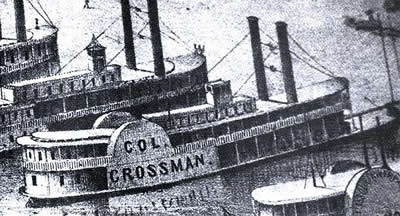
From the lithograph "Bird's Eye View of St. Louis"
drawn and published by James T. Palmatary in 1857.
From the Raymond Ewing collection.
Steamboat: CRESCENT CITY
Built: 1854
Tonnage: 688
Clemens' Service: 29 April - 7 July, 1857
Pilot: Horace Bixby
Co-Pilot: Strother Wiley
Captain: R. C. Young
Fate: 1861 abandoned
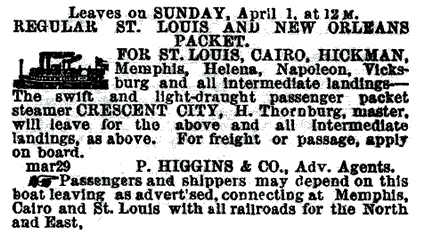
Ad for CRESCENT CITY, 1861
Steamboat: D. A. JANUARY
Built: 1857
Tonnage: 440
Clemens' Service: 16 July - early Aug 1857
Pilot: Horace Bixby
Captain: Patrick Yore
Fate: snagged and lost 18 Dec 1867, Chester, Illinois
NOTE: New research by Michael Marleau indicates that during
this time frame Clemens most likely made a trip up the Missouri River with
pilot Horace Bixby aboard the D. A. JANUARY. Edgar Branch never placed Clemens
on the Missouri River and had previously theorized that Clemens was on board
the RUFUS J. LACKLAND from 11 July to 3 August 1857. Further research by Michael
Marleau includes a new interpretation of Clemens' personal journals and indicates
the 1859 dates are the most likely dates of service for the RUFUS J. LACKLAND
as a licensed pilot.
Steamboat: JOHN J. ROE
Built: 1856
Tonnage: 691
Clemens' Service: 5 August - 24 September, 1857
Pilot: Zebulon Leavenworth and/or Sobieski Jolly
Captain: Mark Leavenworth
Fate: snagged and sunk at New Madrid, MO on 12 September 1864 with 2nd
Wisconsin Cavalry aboard. Losses included 165 horses.
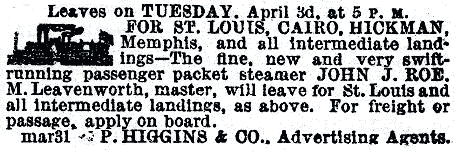
Ad for JOHN J. ROE, 1860
Clemens' comments: I served a term as steersman in the
pilot house. She was a freighter. . . It was a delightful old tug and she
had a very spacious boiler-deck--just the place for moonlight dancing and
daylight frolics. She was a charmingly leisurely boat and the slowest one
on the planet. Up-stream she couldn't even beat an island; down-stream she
was never able to overtake the current. But she was a love of a steamboat.
- Mark Twain's Autobiography
Also see comments above for the Rufus J. Lackland
Steamboat: PENNSYLVANIA
Built: 1854
Tonnage: 486
Clemens' Service: 27 September - 26 November 1857
and 17 February - 5 June 1858
Pilot: William Brown
Co-Pilot: George Ealer
1st Mate: Abner Martin
Captain: John Klinefelter
Fate: 13 June 1858 lost by explosion
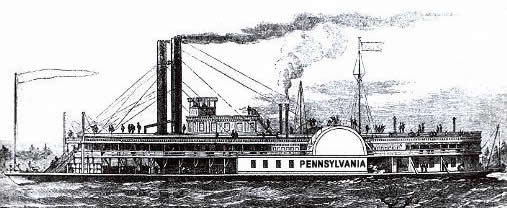
Artist's drawing of the PENNSYLVANIA (based upon the sister ship PHILADELPHIA)
from the Dave Thomson collection.
Clemens' service aboard the PENNSYLVANIA began in November 1857
and was interrupted by a two month gap after the PENNSYLVANIA was involved
in a collision on November 26 with the steamer VICKSBURG twenty-eight miles
north of New Orleans. The PENNSYVLANIA remained in port for repairs and Clemens
later was required to give testimony in a lawsuit regarding the collision.
Clemens' testimony in part: I was on the PENNSYLVANIA as Steersman
at the time of the collision in November last. I was not at the wheel at the
time. At the moment of the collision I was standing on the Sky light deck,
aft of the Pilot house…..I think that at the instant the VICKSBURG struck
us that one of her engines was still going--and my reason for thinking so
is, that she did not recede from us after she struck, but kept pressing on--the
crash of timbers continued--the deck swayed under me, and I thought I heard
the noise of her engines. It was over a minute after the VICKSBURG struck
us, before she began to back away from us. After the boats came together,
I heard the Captain of the VICKSBURG call to Captain
Klinefelter, and I understood him to say that he (Capt White) "Knew
that the VICKSBURG would run from the bar." I am learning the river--have
been learning it, now, about ten months. At that time I had been on the PENNSYLVANIA
about three trips. The PENNSYLVANIA steers very easily, I was in the Pilot
house that night before supper, and I noticed that she steered well--that
is her general character for steering. The PENNSYLVANIA is a first class boat
every way--she is large, and well finished for a passenger boat. The officers
and crew which the PENNSYLVANIA had at the time of the collision were all
of them capable sober and patient. When I was on the extreme stern of the
PENNSYLVANIA as above stated, Capt Klinefelter
was there--I do not know where he was after that. After the collision the
VICKSBURG towed the PENNSYLVANIA to the right hand shore. The VICKSBURG then
backed off. I am not exactly certain whether I was in a position to see her
when she left us. I do not think she landed after she left us--I think she
just backed out, and went up the river. I am certain she did.
- John Klinefelter et. al. vs. Steamer Vicksburg, J. M. White, Master,
National Archives
Clemens' other comments: At the time I speak of I had fallen out of
the heaven of the JOHN J. ROE and was steering for Brown, on the swift passenger
packet the PENNSYLVANIA, a boat which presently blew up and killed my brother
Henry. On a memorable trip, the PENNSYLVANIA arrived at New Orleans, and when
she was berthed I discovered that her stern lapped the fo'castle of the JOHN
J. ROE. I went aft, climb over the rail of the ladies' cabin and from that
point jumped abon the ROE, landing on that spacious boiler-deck of hers. It
was like arriving at home at the farm-house after a long absence. It was the
same delight to me to meet and shake hands with the Leavenworthn and the rest
of that dear family of steamboating backwoodsmen and hay-seeds as if they
had all been blood kin to me. As usual there were a dozen passengers, male
and female, young and old; and as usual they were of the hearty and likeable
sort affected by the JOHN J. ROE farmers. Now, out of their midst, floating
upon my enchanted vision, came that slip of a girl of whom I have spoken --
that instantly elected sweetheart out of the remotenesses of interior Missouri
-- a frank and simple and winsome child who had never been away from home
in her life before, and had brought with her to these distant regions the
freshness and the fragrance of her own prairies.
I can state the rest, I think, in a very few words. I was not four inches
from that girl's elbow during our waking hours for the next three days. Then
there came a sudden interruption. Zeb Leavenworth came flying aft shouting,
"The PENNSYLVANIA is backing out." I fled at my best speed, and
as I broke out upon that great boiler-deck the PENNSYLVANIA was gliding sternward
past it. I made a flying leap and just did manage to make the connection,
and nothing to spare. My toes found room on the guard; my finger-ends hooked
themselves upon the guard-rail, and a quartermaster made a snatcl for me and
hauled me aboard.
That comely child, that charming child, was Laura M. Wright, and I could
see her with perfect distinctness in the unfaded bloom of her youth, with
her plaited tails dangling from her young head and her white summer frock
puffing about in the wind of that ancient Mississippi time -- I could see
all this with perfect distinctness when I was telling about it last Saturday.
And I finished with the remark, "I never saw her afterward. It is now
forty-eight years, one month and twenty-seven days since that parting, and
no word has ever passed between us since."
- The Autobiography of Mark Twain (Neider, p. 80)
In 1858 I was a steersman on board the swift and popular New
Orleans and St. Louis packet, PENNSYLVANIA, (Captain Kleinfelter's boat) . .
. I had found a place on the PENNSYLVANIA for my brother
Henry.
It was not a place of profit, it was only a place of promise. He was "mud"
clerk. . . We made the usual eventless trip to New Orleans -- no, it was not
eventless, for it was on the way down that I had a fight with
Mr.
Brown which resulted in his requiring that I be left ashore at New Orleans.
. . two or three days afterward the boat's boilers exploded at Ship Island,
(on June 13, 1858) below Memphis early one morning and what happened afterward
I have already told in
Life on the Mississippi.
-
The Autobiography of Mark Twain (Neider, p. 100)
(Henry Clemens died in Memphis,
Tennessee on June 21, 1858 his lungs and body having been scalded by steam during
the disaster).
Steamboat: WILLIAM M. MORRISON
Built: 1856
Tonnage: 662
Clemens' Service: 2 December 1857 - 12 Feb 1858
Pilot: Isaiah Sellers
Co-Pilot: George Haggerty
Captain: John Bofinger
Fate: acquired by Confederacy
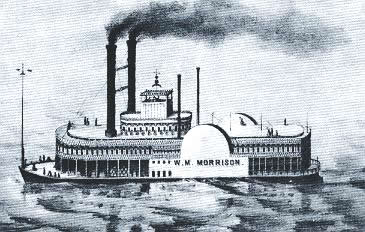
From the lithograph "Bird's Eye View of St. Louis"
drawn and published by James T. Palmatary in 1857.
Courtesy of Dave Thomson.
I am indebted to Michael Marleau for sharing his research for
a forthcoming book which helps indicate the dates Clemens most likely served
aboard the WILLIAM M. MORRISON and for establishing who the pilot and co-pilot
were during this time period. Marleau has also recovered pilot's memoranda
from various newspaper archives, some of which are likely from the pen of
Samuel Clemens during this time frame:
"ONLY ONCE BEFORE"
By Michael Marleau
Printed items called memoranda were occasionally published in the
newspaper river columns of the major port cities along the Ohio, Mississippi
and Missouri Rivers, customarily a brief record or log from which rivermen
"might learn something of the whereabouts and late deeds"
of the steamboats on the rivers. These memoranda were compiled from
simple entries of some notable occurrence while on watch and usually
entered into a log book. By there very nature they were composed of
information that came primarily from the pilothouse and hurricane deck
where the captain, mates and pilots stood their watches when underway.
Periodically passenger and freight information might also be included,
leading to the presumption that a steamboat clerk could have a hand
in the drafting of an individual memoranda. Upon the completion of a
trip these entries were sometimes collected with little or no editing
for the newspapers and members of the river fraternity. As chronicles
of the life and times on the western rivers surviving steamboat log
books available for study are in fact very rare thereby making these
memoranda valuable materials for study. Among the steamboat memoranda
published in the Missouri Democrat, are several that are of a
unique character and fall within the known activities of Sam Clemens.
Clemens was a steersman on the PENNSYLVANIA from late September of
1857 until her collision with the VICKSBURG on the twenty sixth of November
of that year. A week later he was clerking and steering on the WILLIAM
M. MORRISON under the watchful eye of the old pilot Isaiah Sellers.
Sellers was one of the pilots on the J. M. WHITE in 1844 when she set
the speed record for a trip from New Orleans to St. Louis in 3 days,
23 hours and 9 minutes. In February of 1858 the MORRISON was laid up
and Clemens returned to his duties on the repaired PENNSYLVANIA.
In March the MORRISON was back in service and the "high water"
of April "gave her a chance of spreading herself, and she proved
herself very fast." Her memoranda from the Missouri Democrat
tells of her trip:
Steamer
Wm. M. Morrison left New Orleans Sunday, April 4th, at 11 o'clock
A. M., with the United States mail and a fair cargo of freight --
having a fast rising river to Napoleon. Above Natchez the water
was over the banks. From Lake Providence to Napoleon it was over
the levee, and for twenty miles above Greenville the levees were
washed away. Discharged freight at Lake Providence, Greenville,
Napoleon, Helena, Memphis, New Madrid, Island No. 10, Hickman, Cairo
and Chester.
New
Orleans to 81 mile Point 7 hrs 51 min., to Baton Rouge 12 hrs 15
min., to Bayou Sara 15 hrs 45 min., to Morgan's Bend 1 day, to Islands
Nos. 98 and 99 2 days, to Islands Nos. 62 and 63 3 days, to Island
No. 21 4 days, to Devil's Island 5 days. Whole time from port to
port 5 days 14 hrs. Deducted. Running time 5 days 1 hr.
In May the PENNSYLVANIA had a fast trip too. The following memoranda
is from the St. Louis Evening News of May 27, 1858.
Memoranda--Steamer
PENNSYLVANIA left New Orleans on Thursday, May 20th, at 7 P. M.
In Port for St. Louis, steamers R. J. LACKLAND and RR. packets A
T LACEY and FALLS CITY. 21st -- Met RR. packet HIAWATHA at Baton
Rouge. 22d -- Met CITY OF MEMPHIS at Lake Providence, T L MCGILL
head of 93. 23d -- Met NEW UNCLE SAM at 71. 24th -- Met GOLDEN AGE,
CORA ANDERSON at 37, IMPERIAL at Ashport. 25th --Met EDITOR at Island
No. 4, WM. M. MORRISON in Dogtooth Bend; passed J J ROE at Lane's
Landing. 26th -- Met L M KENNETT at Cape Girardeau. Time six days
from port to port. Lost 32 hours by storms and fogs.
The following day, May 28, 1858, the Missouri Democrat also
published a memoranda from the PENNSYLVANIA, but this one was a little
unconventional, a slight bend from the norm, and quite possibly written
by cub pilot Samuel Clemens.
MEMORANDA
-- The PENNSYLVANIA left New Orleans on Thursday, May 20th, at 7
P. M. In port for St. Louis, R. J. LACKLAND, A. T. LACEY and FALLS
CITY. 21st, met HIAWATHA at Baton Rouge, CITY OF MEMPHIS at Lake
Providence; T. L. MCGILL at head of 93; NEW UNCLE SAM at 71: CORA
ANDERSON at 37; IMPERIAL at Ashport. 25th, EDITOR at island 4; WM.
M. MORRISON in Dogtooth bend. Time from port to port 3 days and
72 hours. Only once before has a trip been made in 3 days and some
hours.
The reference to "only once before" has such a trip been
made is a poke in jest directed at Isaiah Sellers as he was one of the
pilots of the fleet J. M. WHITE in 1844. The "Only once before"
item was published in the Democrat, the same paper the memoranda
from Isiah Seller's log had been published a few weeks earlier. It is
likely Sam Clemens was the author of the memoranda. Clemens would later
recall how the "Oldest Pilot" was "full of strange lies
& worldly brag" and probably bored the steersman with his boasting
of the exploit.
In his personal notebooks for 1881-82 Clemens penned a similar river
joke: "Trip up Missouri river 3300 miles made fastest time on record
viz. 3 days 9 hours and 4 months" (Mark Twain's Notebooks &
Journals, vol. 2, p. 574).
|
Steamboat: ALFRED T. LACEY
Clemens' Service: 11 - 28 July 1858
Built: 1857
Pilot: possibly
Barton Bowen
Co-Pilot: possibly
George Ealer
Captain: John P. Rodney
Fate: burned April 26, 1860 with loss of sixteen lives including Captain
A. T. Lacy's daughter
Steamboat: JOHN H. DICKEY
Built: 1857
Tonnage: 403
Clemens' Service: 4 August - 19 October 1858
Pilot: possibly
Samuel Bowen
Co-Pilot: possibly
Strother Wiley
Captain: Daniel Able
Fate: Survived the Civil War; dismantled July 8, 1865
Clemens' comments: I am now on my return from Memphis,
on the steamer John H. Dickey, and allow me to say that the steamer named, is
one of the finest boats now running between St. Louis and the above mentioned
port. Capt. Dan Able is one of the accommodating sort, and I predict that he
will continue always to receive a large share of the patronage of the business
and traveling community.
- "Our Special River Correspondence," St. Louis Missouri Democrat,
1 September 1858 (signed "Rambler"; identified by Walter Branch as
Samuel Clemens)
Steamboat: WHITE CLOUD
Built: 1857
Tonnage: 345
Clemens' Service: 20 - 26 October 1858
Pilot: probably
Samuel Bowen
Captain: Daniel Able
Fate: Converted to troop transport; took the 7th Iowa Volunteers up the
Tennessee to Pittsburg Landing;
with Admiral David D. Porter on the Red
River in 1864; sank in the ice at St. Louis 12 February, 1867.
Steamboat: NEW FALLS CITY
Built: 1858
Tonnage: 880
Clemens' Service: 30 October - 8 December 1858
Pilot: probably Horace Bixby
Captain: James B. Woods
Fate: 1861 acquired by Confederacy and later sunk in Red River to
block river traffic. Wreckage wasn't cleared until 1880.
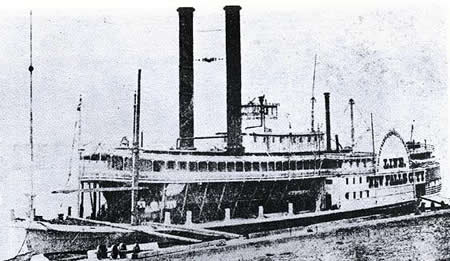
Photo from the Raymond Ewing collection.
Steamboat: ALECK SCOTT
Built: 1848
Tonnage: 709
Clemens' Service: 13 December 1858 - 8 April 1859
Pilot: Horace Bixby
Captain: Robert Reilly
Fate: May 1862 acquired by Union and renamed FORT HENRY; later converted
to gunboat and renamed LAFAYETTE
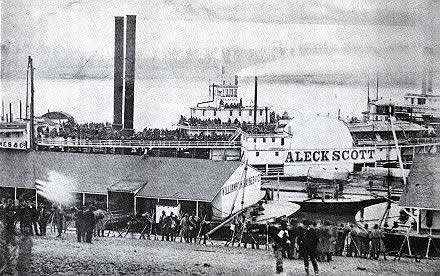
Aleck Scott converted to troop transport after the Civil War began.
Around 1887 Duke's Cigarettes issued unsigned miniature biographies
of titled "Histories of Poor Boys Who Have Become Rich and Other Famous
People." The Twain issue contained the following yarn which supposedly
came from a crew member of the ALECK SCOTT:
| "I was
the first engineer of the Alexander (Aleck) Scott when Sam Clemens was a
cub in her pilot house. He was a chipper young chap, with legs no bigger
'n a casting line, and fuller of tricks than a mule colt. He worked off
jokes on everybody aboard, from the skippers down to the roustabouts, and
they were all taken in good part; but I lay by two or three to pay back.
About the time that Sam got the run of the river enough to stand alone at
the wheel, the Scott went into the lower river trade; carrying cotton from
Memphis to New Orleans. If you know anything about cotton, I needn't tell
you that you may cover it from stem to stern with tarpaulins and keep your
donkey engine steamed up, but if a spark of fire touches cotton enough to
fill a tooth, your boat's a corpse. It's quicker 'n gunpowder to burn, and
no pilot can reach the lower deck from the texas in time to save himself,
let alone his Saratoga.
"So,
you see, everybody in that trade is on the watch, and an alarm of fire
in a boat loaded with cotton will turn a man's hair gray quicker 'n an
alligator can swaller a nigger.
"Sam,
being a young pilot, and new to the cotton trade, was told over and over
again how the profession would lose a promising cub if ever a fire broke
out on the Scott, and the boy got nervous. My striker and me always managed
to be in the lunch-room when Sam came off watch, and as he came in we
would talk about the number of cotton boats that burnt in such a year,
and how such a cub would have made a lightning pilot if he hadn't got
burnt up in the cotton trade - and we always noticed that Sam's appetite
failed him after that, and instead of going to bed he would go prowling
round the lower deck and peering about the hatchways, smelling at every
opening like a pup that had lost its master.
"One
day, when we backed out of Memphis with a big cargo of cotton, I complained
in Sam's hearing that the mate had loaded the boat too near the engines.
The boy followed me into the engine-room, and, without seeming to notice
him, I told my striker I would do my level best to keep that cotton from
catching fire; but that it was a slim chance, with bales piled up right
in front of the furnace doors. Sam got whiter 'n a bulkhead, and went
up to the texas, where he packed his Saratoga, ready for any business
that might come up before the meetin'. When he went on watch I posted
the second clerk to keep an eye on him. He hid behind a smokestack and
saw Sam alone in the pilot house, his hair on end, his face like a corpse's,
and his eyes sticking out so far you could have knocked them off with
a stick. He danced around the pilot-house, turned up his nose as if he
was smelling for a polecat, pulled every bell, turned the boat's nose
for the bank, and yelled 'FIRE!' like a Comanche Indian on the war-path.
That yell brought everybody on deck. We had a big cargo of passengers,
and the women screeched, the men rushed for cork pillows, and the crew
yanked the doors off their hinges and rushed to the guards, ready to go
overboard at the first moderation of weather. The skipper had hard work
to make the crazy passengers believe that there wasn't any fire, but he
brought them to reason finally. I paid no attention to Sam's frantic yells,
so the boat didn't run her nozzle against the bank he aimed for.
"The
captain, and pilot, and a lot of passengers, after hunting all over the
boat, couldn't find a sign of fire anywhere outside the furnaces, and
then they went for Sam. He swore up and down that he smelt cotton burning;
no use talking to him--he knew the smell of burning cotton, and, by thunder,
he had smelt it. The first pilot said kinder soft and pitying to him:
'Sam, my boy, if you'd told me you was so near the jim-jams, I'd stood
double watch for you. Now go and soak your head in a bucket of water,
take a good sleep, and you'll be all right by to-morrow.' Sam just biled.
over at this; and when a pretty young woman passenger said to the skipper,
loud enough for Sam to hear: 'So young and nice-looking, too - how sad
it will make his poor mother feel to hear how he drinks!' he fairly frothed
at the mouth. You never see a fellow so toned down as Sam was after that;
and, though the boys never quit running him, he never talked back, but
looked kind of puzzled - - as though he was trying to account for that
smell of cotton smoke."
"And
what was the cause of the smell!" the old engineer was asked.
He chuckled
a full minute and then said: "You see, there's a speaking-tube running
from the engine room to the pilot-house. I had in mind the tricks Sam
had played me, and, having worked him to a nervous state about fire I
waited till he was alone in the pilot-house, and then set fire to a little
wad of cotton, stuffed it into the speaking-tube, and the smell came right
out under his nose."
- Life
of Mark Twain, (New York: Knapp & Company, 1887). A tiny 15-page
Duke's Cigarettes "premium" measuring 1.20 X 2.80 inches. From
the Dave Thomson collection.
|
Clemens' comments: I will remark, in passing, that Mississippi
steamboatmen were important in landsmen's eyes (and in their own, too, in a
degree) according to the dignity of the boat they were on. For instance, it
was a proud thing to be of the crew of such stately craft as the "Aleck Scott"
or the "Grand Turk." Negro firemen, deck hands, and barbers belonging to those
boats were distinguished personages in their grade of life, and they were well
aware of that fact, too.
- Life on the Mississippi

Quotations | Newspaper Articles
| Special Features |
Links | Search









